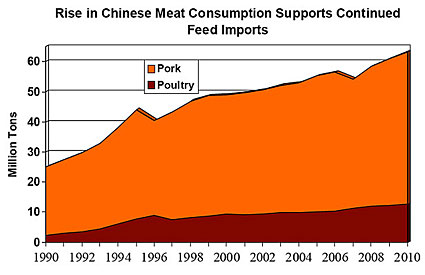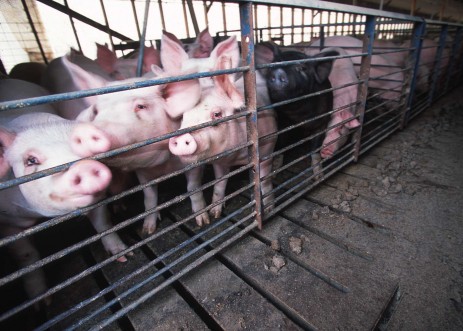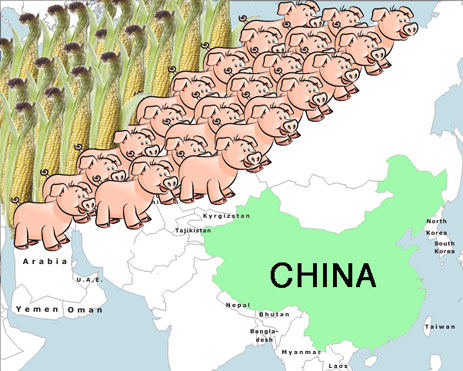 Now that we’ve figured out why the climate bill died, it’s time to start thinking about the consequences. The failure doesn’t just mean that U.S. greenhouse gas emissions will continue inching up. It also means that we probably won’t see a global climate deal anytime soon. And that means untold years of ever-increasing emissions — and likely dire consequences for human habitation on Earth.
Now that we’ve figured out why the climate bill died, it’s time to start thinking about the consequences. The failure doesn’t just mean that U.S. greenhouse gas emissions will continue inching up. It also means that we probably won’t see a global climate deal anytime soon. And that means untold years of ever-increasing emissions — and likely dire consequences for human habitation on Earth.
Think about a global climate pact from China’s perspective. Why should it take leadership, now that the U.S. has refused to act? Sure, China stands as the globe’s most prodigious greenhouse gas emitter, and its annual emissions are growing rapidly. But in terms of emissions per person, China stills lags behind us dramatically — the average Chinese person has less than a fourth of the carbon footprint of her U.S. counterpart. Moreover, we prosperous consumers in the post-industrial global north are deeply implicated in China’s voracious and growing demand for dirty fossil fuels. According to one study, fully one-quarter of China’s GHG emissions stem from its export trade to Europe and the United States. Think about that next time you reel in goodies (including iPhones and other tech gadgets) at the nearest Big Box.
In China, the most visible consequence will likely be a growing proliferation of cars. As Scientific American put it:
Even though China only has 24 cars for every thousand Chinese (compared to 800 cars for every thousand Americans) the country is on pace to become the world’s largest purchaser of automobiles by 2020 — and this growing love affair between the Chinese and driving is a risk for the entire planet.
But the country’s growing appetite for meat — and its rapid conversion to U.S.-style industrial meat production — may prove just as damaging. Consumption of grain-intensive meat carries has a massive greenhouse gas footprint (although the claim that it’s greater than that of transportation has come into question). Chinese diners still have much to learn from us in terms of gross carnivory. As of 2002 — the last year for which I can find data — U.S. citizens were putting away 125 kg of meat per capita each year, vs. 52 kg for Chinese people.
 (USDA)As in other areas, as the nation industrializes, the meat gap is closing. Consumption of pork, the most popular meat in China, tells the story. According to this 2010 USDA report [PDF], Chinese pork consumption jumped from 22 million tons in 1990 to more than 50 million tons in 2009 — a 127 percent increase in just 20 years. Today, the nation consumes about half of all pork produced worldwide.
(USDA)As in other areas, as the nation industrializes, the meat gap is closing. Consumption of pork, the most popular meat in China, tells the story. According to this 2010 USDA report [PDF], Chinese pork consumption jumped from 22 million tons in 1990 to more than 50 million tons in 2009 — a 127 percent increase in just 20 years. Today, the nation consumes about half of all pork produced worldwide.
And as consumption surges, the nation’s corn production has failed to keep up with the needs of the budding livestock industry. And that means a massive push to import corn. In a startling recent speech at the U.S. Grains Council — an organization that dedicates itself to “developing export markets for U.S. barley, corn, grain sorghum, and related products” — a prominent Chinese agribusiness analyst declared a “new era” in world corn markets had dawned.
According to an account of the speech on the evocatively named Agrimoney.com website, the analyst declared that Chinese corn imports will surge from zero in 2008 to 15 million metric tons by 2014, because “China’s demand for corn, used largely as livestock feed, was ‘simply outstripping’ domestic production.” (A metric ton is a bit more than a U.S. ton — about 2,205 pounds.) To put 15 million metric tons in perspective, let’s consult the National Corn Growers Association’s ever-useful publication, 2010 World of Corn [PDF]. Last year, WOC tells us, the globe’s nations imported a total of 85 million metric tons of corn, of which China accounted for only a tiny part. If we add in China’s expected 15 million-metric-ton buy in 2014, global corn imports will surge to 100 million metric tons — an 18 percent jump in just five years.
Note that corn is a massively resource-intensive crop. Our corn crop sucks in nearly 40 percent of all nitrogen fertilizer applied in the United States, and upwards of 30 percent of phosphorous and potash. (Numbers crunched from USDA data, see table 2.) Such voracious use of fertilizers causes all manner of ecological trouble — not least of which is emissions of nitrous oxide, a greenhouse gas some 300 times more potent than carbon dioxide. (See our recent series on nitrogen fertilizer, as well as this discussion of the ravages of phosphorous mining.)
Where will China get this massive cache of corn? According to WOC, the United States is by far the world’s biggest corn exporter. In 2009, it exported 52 million metric tons, accounting for 60 percent of global corn exports, easily besting its two closest rivals, Argentina and Brazil, each of which accounted for about 10 percent of global exports. But between now and 2014, an ever-increasing share of U.S. corn will be going into ethanol production; and U.S. farmers are already dedicating near-record amounts of land to corn.
That means that China’s demand surge will likely be met by Argentina and Brazil, with their vast reserves of uncultivated land. Those nations will likely convert more grassland and savanna to corn production — unleashing untold quantities of carbon in the conversion process, and subjecting millions of acres of land to a cascade of fossil fuel-derived agrichemicals. The result will be a boon for U.S. agribusiness titans like Archer Daniels Midland, Cargill, and Monsanto, which dominate the global grain trade and provide the inputs necessary for industrial corn production.
And that won’t be the only way U.S. interests benefit from surging Chinese meat consumption. The handful of companies that dominate U.S. meat production are itching for the chance to access the China market. China has tried to be as self-sufficient as possible in meat, repeatedly shutting down its relatively modest trade with U.S. pork producers — the latest instance of which involved the 2009 swine-flu scare. China reopened its market to U.S. pork recently — and our meat merchants fervently hope that this trade trickle will turn into a gusher.
Obama’s U.S. Trade Office — whose agricultural operations are led by former agrich
emical-industry lobbyist Isi Sidiqqui — vigorously supports that goal. USDA chief Tom Vilsack is on board, too. “When I traveled to China with U.S. Trade Representative Kirk in October, our discussions with Chinese officials laid the groundwork for reopening this market,” Vilsack recently boasted. He called the reopening of the China market to U.S. pork “excellent news for American hog producers.”
In a Reuters article on pork last spring, Iowa State economics professor Dermot Hayes laid out the scale of the China opportunity in blunt terms. “If China really left markets work, and gave us 5 to 10 years we could be exporting 50 percent of [all the pork] the U.S. produces just to that one country,” Hayes told Reuters. “Long term, China is land scarce and Asian countries that are land scarce traditionally import a lot of pork, as much as 25 percent of what they consume. Japan is up at 50 percent.” He added:
They [China] have a lot of inefficient pork production — very labor intensive — and they have a better use for those individuals in the cities at construction sites. So as they leave the countryside, there is a huge potential for pork to replace the backyard production that will quit.
 This is what China wants — and will get — from us: more Concentrated Animal Feeding Operations, or CAFOsHayes’ remark about “inefficient pork production” points to a second way U.S. meat giants could benefit from the vast and growing China market. Not only could companies like Tyson and Smithfield export enormous amounts of industrial pork to China, but they could also provide consulting services on how to wipe out millions of small-scale hog farmers and concentrate production into vast CAFOs. That’s the feat performed by U.S. hog giants like Smithfield in the 1990s — and it’s precisely what China is attempting to do, working directly with U.S. meat companies.
This is what China wants — and will get — from us: more Concentrated Animal Feeding Operations, or CAFOsHayes’ remark about “inefficient pork production” points to a second way U.S. meat giants could benefit from the vast and growing China market. Not only could companies like Tyson and Smithfield export enormous amounts of industrial pork to China, but they could also provide consulting services on how to wipe out millions of small-scale hog farmers and concentrate production into vast CAFOs. That’s the feat performed by U.S. hog giants like Smithfield in the 1990s — and it’s precisely what China is attempting to do, working directly with U.S. meat companies.
Back in 2008, Smithfield cemented its ties with China by selling 5 percent of its shares to the state-owned COFCO Group, China’s largest food importer and exporter and a budding pork producer. As part of the deal, Smithfield agreed to lend lend COFCO its industrial hog-production expertise.
Forbes reported at the time that COFCO was then slaughtering half a million hogs annually, “under contract with small producers.” In partnership with Smithfield, COFCO hopes to boost production to between 10 million and 15 million hogs within three to five years. Here the kicker: they’ll be “raised in accordance with standards and practices prevailing in the United States.” Smithfield’s practices were aptly described in the legendary 2006 Rolling Stone article, “Boss Hog.”
Another Chinese company, Agfeed Industries, is also leaning on U.S. pork industry players to assemble what it calls a “a fully integrated production system from the feed that the animals eat, to their breeding and growth, and finally to slaughter and processing.”
To build out its “western style farm system,” Agfeed has tapped U.S. industry veteran Gerry Daignault as its “Chief Operating Officer, Head of Hog Production and Strategic Development.” And just last week, Agfeed bought U.S. hog producer M2P2, which raises 1.3 million hogs each year. The purpose of the deal was to “help AgFeed boost its hog production by implementing more efficient Western-style production methods,” an Agfeed adviser told Associated Press.
Thus, aided by U.S. agribusiness execs and cheered on by U.S. trade officials, China looks set to dramatically ramp up pork consumption, both by importing finished product from the United States and industrializing its own production. Mountains of corn, grown with gushers of synthetic nitrogen and other fossil fuel-related inputs, will be needed. The climate implications are startling.
It’s the kind of thing only a global climate deal, brokered by the U.S., could stop.



